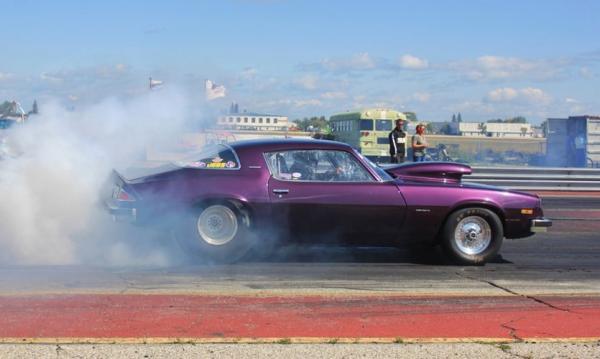Sonoma Raceway Aims to Make Racing Less of a Drag on the Earth
- July 26 2019
- 3 min read
Sonoma Raceway Aims to Make Racing Less of a Drag on the Earth

With some of the loudest sounds and brightest lights, dozens of drag racing cars will be zooming down a short stretch of California's Sonoma Raceway, this weekend. Reaching speeds of more than 300 mph, they'll burn shocking amounts of fuel.
It's not exactly the public image of California as a state full of pollution slashing, climate tackling Earth lovers.
As the state develops climate goals with growing ambitions, leaning on automakers to build more efficient cars, raceway officials are looking for a balance between being green and keeping their sport alive.Some of the ways Sonoma is embracing sustainability in their everyday operations include huge numbers of solar panels and an elaborate effort to reuse oil, among other fluids, while showcasing green vehicle technology.
"Our place in the sustainability movement might be a little suspect
Sonoma Raceway President Steve Page—this is not an industry where you might be used to seeing eco-friendly initiatives. But I think that gives us an interesting platform"
It's hard to measure the carbon footprint of races, such as this weekend's annual Sonoma Nationals. It depends not only upon the number of cars but their engine specifications, the age of the vehicle, and the very specialized fuel. This information is according to Dave Clegern. Clegern is a spokesman for the state's are regulator, the California Air Resources Board.
Top Fuel Dragsters, the long, ultra-fast kings and queens of drag racing, can use up to 23 gallons of a fuel known as nitromethane in only 1,000 feet! This is much more than ordinary vehicles! Sonoma's fuel usage is especially high. The course is close to sea level, which allows cars to take more oxygen into the engines, allowing for more fuel, than raceways at higher altitudes.
Clergen stated that racing vehicles are exempt from state air quality regulations.
"One perspective might be that motor sport will have a hard time adapting to the shift toward environmentalism and sustainability."
IndyCar Driver J.R. Hildebrand
Hildebrand has driven the Sonoma course many times and taught at Stanford's vehicle dynamics lab. He mentioned that, however, the sport seeks to demonstrate new technology, and "over the next decade, that core philosophy will be embraced more and more—out of both opportunity and necessity."
For the past two years, Sonoma Raceway has hosted the Shell Eco-Marathon, which invites 1,000 high schoolers and college students to build energy efficient vehicles.
As far as drag racing is concerned, some cars run on ethanol. The good news is that ethanol is alcohol-based and produces less carbon dioxide per gallon than regular gasoline. The other side of that coin is that it is often made from corn, or other crops, which requires carbon-intensive farming.
Sometimes, a few all-electric Teslas are included in the mix of vehicles, showcasing their dramatic acceleration.
"Anyone who's hit the pedal in a Tesla in 'insane' mode knows that you have a chance to be pretty dominant on your local drag strip."
Sonoma Raceway President Steve Page
Electric cars do not make any noise, which is a huge loss to the appeal of drag racing, so this technology may not catch on too quickly.
But, it's not all about the cars. Behind the scenes, the raceway is working to recapture used oil, cleaning solvents, fluids and lubricants, and re-refine them for further use.
The raceway also includes 1,650 solar panels, which provide two-fifths of its energy needs. The 1,600 acre grounds, over half of which is comprised of native grasslands, is tended to by 3,000 sheep. For the stands, officials chose locally sourced, sustainably grown redwoods.
After use, banners, billboards, flags, and signs are sent to Santa Rosa textile manufacturer TekTailor where they are turned into usable products such as tote bags and backpacks. VIP attendees' wine gifts are delivered in bags made from recycled raceway materials.
Do you have banners, billboard, flags, or signs that you want turned into bags? Custom Earth Promos can place your logo on a reusable bag made from a number of sustainable materials.
The biggest climate negative, however, most likely comes from the fans. Most people arrive by driving. The raceway is not easily reached by public transportation. This problem, though, is hardly specific to drag racing. Any entertainment facility drawing large crowds and lots of cars could result in substantial amounts of pollutants, says Clegern.
Page states that "a good amount of people will camp overnight" at Sonoma, noting that at least they won't be making the drive every day. He believes that the assumption that people who take an interest in automobiles don't care about the environment is a myth.
Hildebrand has said that Californians, in particular, seem to be able to blend having a zero-emissions car for everyday use, with an enthusiasm for unconventional automobiles.
Keep your keys for all kinds of vehicles on a lanyard made from sustainable materials.
"More and more California garages reflect both of these things. There's a Tesla for daily use and a vintage Porsche for the weekends."
IndyCar Driver J.R. Hildebrand
Gain access to Orders, Tracking, Custom Options and Much More!